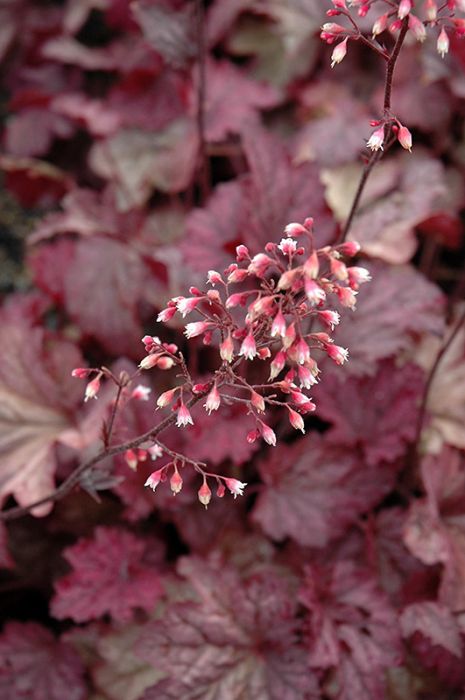Heuchera, Red Leaf Coral Bells 'Berry Smoothie'



- Sun Preference
- Full-Sun, Part-Sun
- Bloom Time
- June, July
Description
Large, impressive cultivar that emerges bright rose pink in the spring, later darkening to purple rose in summer.
Minnesota's Largest Selection of Perennials
Discover an unparalleled selection of perennials at Gertens! With the largest variety in Minnesota, we offer endless options of colorful perennials, natives, and pollinator plants to beautify your garden year after year. From vibrant flowers to lush foliage, our perennials are perfect for adding beauty and charm to your outdoor space. Visit Gertens today and see why we're known as Minnesota's Destination Garden Center!
Details
Berry Smoothie Coral Bells | Heuchera 'Berry Smoothie'
Height: 22 inches
Spacing: 15 inches
Sunlight: full sun to full shade
Hardiness Zone: 4a
Other Names: Coralbells, Alumroot
Brand: Gertens
Description:
Dainty spikes of ivory white bells rise from a compact mound of rose foliage that matures to a bronzy-red by summer; amazing contrast to other plants, great versatility; keep soil moist in the heat of summer
Ornamental Features
Berry Smoothie Coral Bells features dainty spikes of white bell-shaped flowers rising above the foliage from late spring to early summer. Its attractive crinkled lobed leaves emerge rose in spring, turning scarlet in color with distinctive dark red veins and tinges of coppery-bronze the rest of the year.
Landscape Attributes
Berry Smoothie Coral Bells is a dense herbaceous evergreen perennial with tall flower stalks held atop a low mound of foliage. Its relatively fine texture sets it apart from other garden plants with less refined foliage.
This is a relatively low maintenance plant, and should be cut back in late fall in preparation for winter. It is a good choice for attracting hummingbirds to your yard. It has no significant negative characteristics.
Berry Smoothie Coral Bells is recommended for the following landscape applications;
- Mass Planting
- Rock/Alpine Gardens
- Border Edging
- General Garden Use
- Groundcover
- Container Planting
Planting & Growing
Berry Smoothie Coral Bells will grow to be about 22 inches tall at maturity, with a spread of 22 inches. When grown in masses or used as a bedding plant, individual plants should be spaced approximately 15 inches apart. Its foliage tends to remain dense right to the ground, not requiring facer plants in front. It grows at a medium rate, and under ideal conditions can be expected to live for approximately 10 years. As an evegreen perennial, this plant will typically keep its form and foliage year-round.
This plant performs well in both full sun and full shade. It prefers to grow in average to moist conditions, and shouldn't be allowed to dry out. It is not particular as to soil type or pH. It is somewhat tolerant of urban pollution. Consider applying a thick mulch around the root zone in winter to protect it in exposed locations or colder microclimates. This particular variety is an interspecific hybrid. It can be propagated by division; however, as a cultivated variety, be aware that it may be subject to certain restrictions or prohibitions on propagation.
Berry Smoothie Coral Bells is a fine choice for the garden, but it is also a good selection for planting in outdoor pots and containers. With its upright habit of growth, it is best suited for use as a 'thriller' in the 'spiller-thriller-filler' container combination; plant it near the center of the pot, surrounded by smaller plants and those that spill over the edges. It is even sizeable enough that it can be grown alone in a suitable container. Note that when growing plants in outdoor containers and baskets, they may require more frequent waterings than they would in the yard or garden. Be aware that in our climate, most plants cannot be expected to survive the winter if left in containers outdoors, and this plant is no exception. Contact our experts for more information on how to protect it over the winter months.
More Information
| Common Family Name | Coral Bells |
|---|---|
| Gerten Grown Plants | Gerten Grown Plants |
| Available for Pre-Order | Yes |
| Sun Preference | Full-Sun, Part-Sun |
| Bloom Time | June, July |
| Mature Spread (Range) | 12" - 24" |
| Mature Height (Range) | 13" - 24" |
| USDA Hardiness Zone | 4, 5, 6, 7, 8 |


